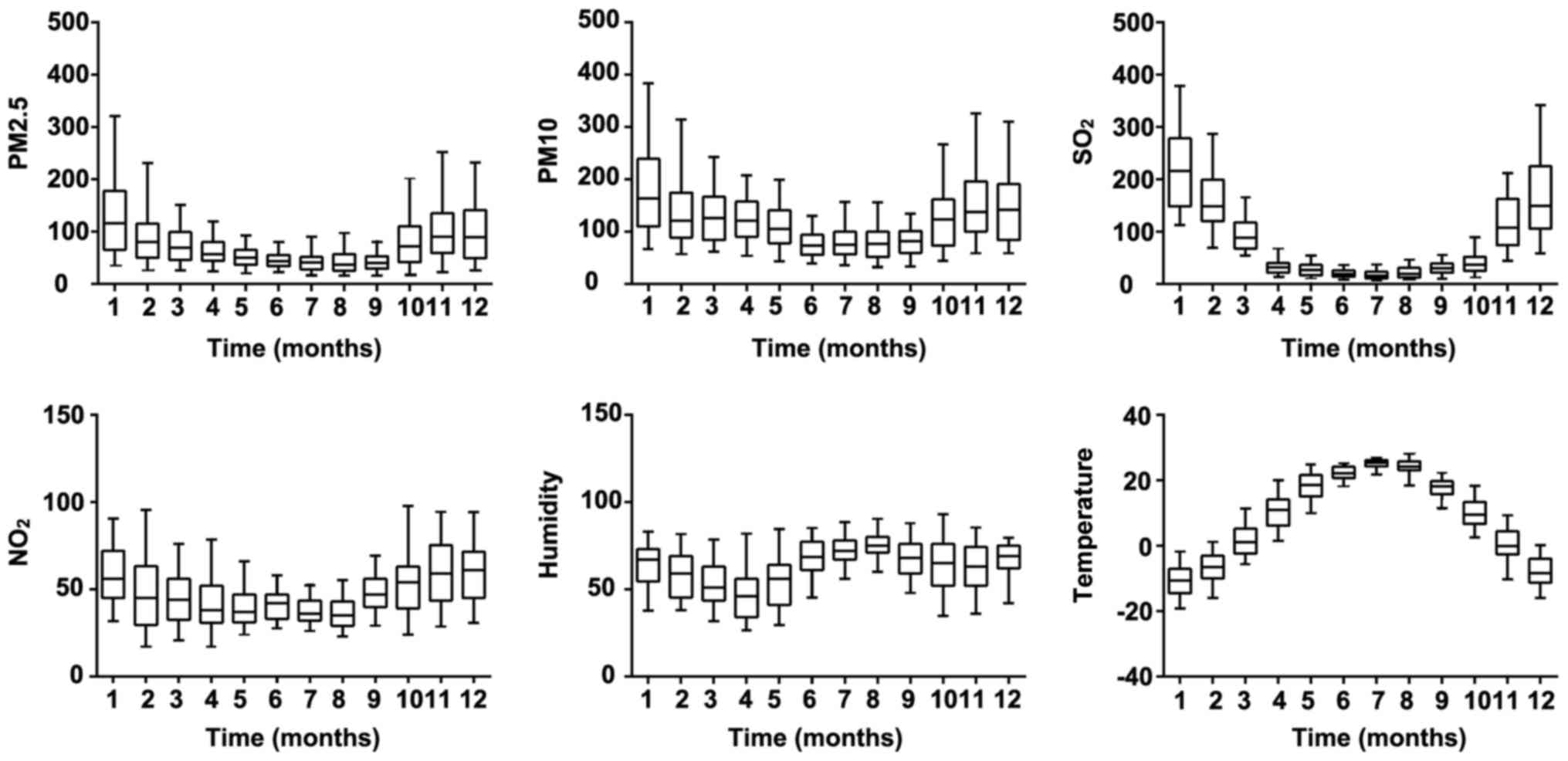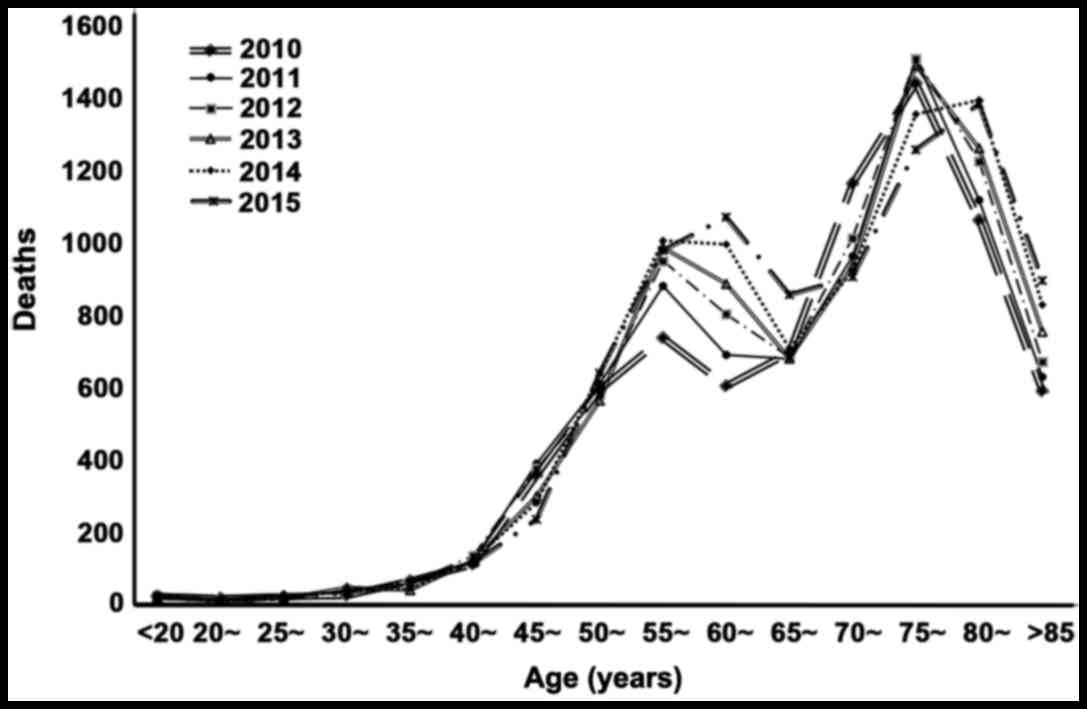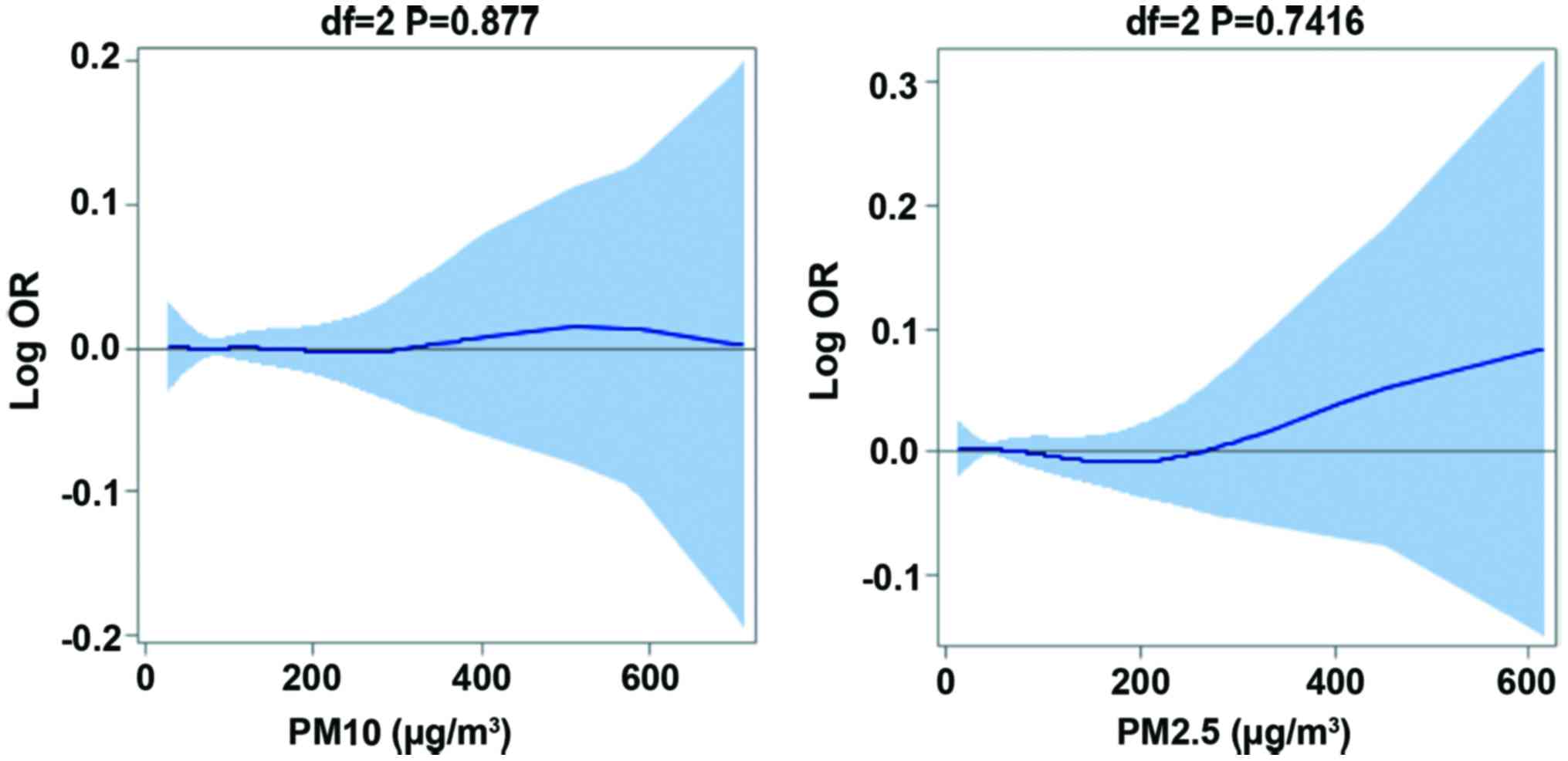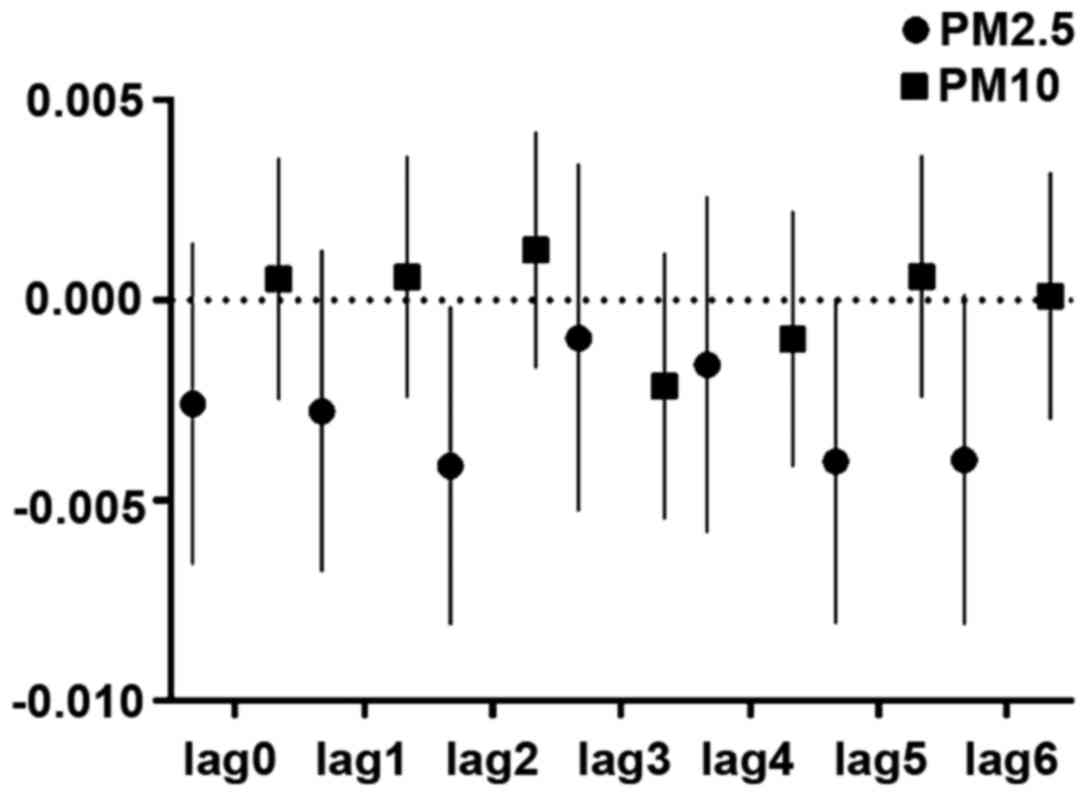Introduction
The industrialization process in China aggregated
environmental pollution (1). Signs of
extreme pollution, such as extremely high PM2.5 levels, are
frequently observed in major cities of China, such as Beijing
(2). Air pollution caused by a series
of environmental health issues has attracted more and more
attentions. Airborne particulate matter (PM) is a mixture of
gaseous or liquid particulate matter that floats in the air
(3). Inhalable particles are
classified into three categories: coarse particles (d=2.5–10 µm),
fine particles (d=0.1–2.5 µm), and very fine particles (d<0.1
µm) (4). Studies have shown that the
main chemical constituents of respirable particulate matter can be
divided into four major categories: soluble components (mostly
inorganic ions), organic components, trace elements and carbon
elements. In 1994, the American Cancer Institute (ICR) reported
that particles >10 µm cannot enter the respiratory tract,
particles between 5–10 µm are basically blocked in the upper
respiratory tract, particles <5 µm can enter the alveoli and
bronchi, and fine particles <2.5 µm can easily enter the alveoli
(5). PM2.5 can be suspended in the
atmosphere for a long time, and can even stay up to 30 days. During
this period, due to the small gravitational effect of PM2.5 and
large specific surface area, it can adsorb a variety of complex
components, such as a variety of toxic substances, heavy metal
compounds, pathogens, bacteria and other microorganisms (6). PM2.5 induces genotoxicity (DNA damage),
oxidative stress and inflammation (7–10).
Epidemiological studies have confirmed the significant correlations
between particulate air pollution and various adverse health
effects (11). Several landmark
review studies have shown that exposure to PM2.5 is associated with
premature death and increased incidence of respiratory and
cardiovascular disease (12,13). Accurate environment PM2.5
concentration measurements are critical to epidemiological studies
of chronic human exposure, but also are big challenges (14).
At present, most studies have linked air pollution
to cardiovascular and respiratory disease, but studies on the
association between air pollutants and malignancies are rare.
Therefore, this study analyzed the association between air
pollutants and the death resulting from malignant tumors from 2010
to 2015 in Shenyang, China.
Patients and methods
Health data
We analyzed data of malignant tumor-related deaths
in five urban areas in Shenyang, China from 2010 to 2015. The data
were obtained from the Shenyang Center for Disease Control and
Prevention statistics. Between 2010–2015, 48,084 people (27,987
men, 20,097 women) people died of malignant tumors. Mortality data
are recorded according to the 10th edition of the International
Classification of Diseases and Related Health Statistics. The
protocol of this study has been approved by the Ethics Committee of
Shenyang Medical College (Shenyang, China). All patients signed
informed consent.
Exposure data
According to the ‘Environmental Air Quality
Standard’ established in China in 2013, the average concentration
of air fine particles (PM2.5) and ozone (O3) was added
to the original sulfur dioxide (SO2), nitrogen dioxide
(NO2) carbon monoxide (CO), respirable particulate
matter (PM10) monitoring indicators. The daily air pollution data
used in this study include continuous monitoring of PM2.5, PM10,
SO2, NO2 concentrations in five urban
districts in Shenyang. PM2.5 data are only available between
2013–2015, and other pollutant data covered 2013–2015. Those data
were obtained from Shenyang Environmental Monitoring Center Station
and Shenyang Environmental Protection Bureau of China. Daily
average temperature, wind speed, pressure and relative humidity and
other weather data from 2010 to 2015 were provided by Shenyang
Meteorological Bureau.
Data analysis
The health and exposure data of this study were used
to predict the association between atmospheric particulate exposure
and malignancy mortality using a generalized linear model (GAM)
based on the Poisson distribution combined with time sequence
analysis using the time sequence analysis, The function of
estimating the possible hysteresis effect of air pollution. Based
on the generalized cross-validation (GCV) selection of the degree
of freedom (df) of the lag results, the most suitable model with 7
df is found (lag 0–6). Data are stratified according to different
seasons (warm season, May-October; winter, November-April). The
number of deaths from malignant tumors varies with the
concentration of PM in the environment as follows: LogE(Yt) =
para(SO2, NO2, PM10, PM2.5) + spline(year,
df) + spline(mouth, df) + spline(temperature, df) +
spline(hunidity, df) + dow + holiday + αPMt-1, t.
Where E(Yt) represents the number of expected
malignancies on day t, the spline is a natural cubic spline, and
PMt-1 represents the mean 2-day concentration at days t
and 1. First, the hysteresis effect of air pollution was tested by
single-day lag. The most likely lag time was then determined after
the establishment of a single contaminant model. The effect of each
pollutant additional 10 µg/m3 on the death of malignant
tumors at different times was analysed. Since PM2.5 data are
provided only between 2013–2015, all analyses in this study for
PM2.5 are only valid for those 3 years. Statistical analysis of
this study was performed using VR3-2.5 (R Project for Statistical
Computing), GraphPad Prism 7 (GraphPad Software, NY, USA) and SPSS
22.0 (IBM Corp., Armonk, NY, USA).
Results
In< this study, to the best of our knowledge, we
first summarized the meteorological, environmental and death
statistical data collected during the 2010–2015 period. Table I summarizes the number of malignant
tumor deaths, concentrations of SO2, PM10,
NO2 and PM2.5, relative humidity, and temperature during
the period of 2010–2015 in Shenyang. Results showed that the
average SO2, PM10, NO2 and PM2.5
concentrations were 122.37 µg/m3, 74.75
µg/m3, 79.36 µg/m3, and 47.65
µg/m3, respectively. In the warm season, the number of
deaths caused by malignant tumors is greater than that in the cold
season. PM2.5 and PM10 in the cold season (96.53 and 149.92
µg/m3) are higher than those in the warm season. In
Shenyang, China, the average temperature is −2.07°C during cold
season and is 19.45°C during the warm season. Fig. 1 shows the concentrations of PM2.5,
PM10, SO2 and NO2, relative humidity and
temperature in Shenyang, China, and higher values of those factors
were found in the cold season than in the warm season. In the
analysis of the interrelationships between different air pollutants
and meteorological factors, it was found that there were
significant correlations between the four major air pollutants,
such as the correlation between PM2.5 and PM10 and the correlation
between temperature and relative humidity (Table II).
 | Table I.Daily air pollutants, meteorological
conditions, and number of malignant tumor deaths in Shenyang, China
between 2010–2015, are shown throughout the year and in the cold
and warm seasona. |
Table I.
Daily air pollutants, meteorological
conditions, and number of malignant tumor deaths in Shenyang, China
between 2010–2015, are shown throughout the year and in the cold
and warm seasona.
| Variables | All | Cold | Warm |
|---|
| No. of cancer
deaths | 22.27±4.98 | 21.93±4.98 | 22.6±4.96 |
| SO2 | 79.36±81.05 | 132.83±85.3 | 26.76±17.26 |
| PM10 | 122.37±81.33 | 149.92±93.3 | 95.26±55.56 |
| NO2 | 47.65±18.2 | 52.53±20.56 | 42.85±13.98 |
| PM2.5 | 74.75±61.8 | 96.53±71.09 | 53.32±41.05 |
| Relative
humidity | 62.81±15.56 | 58.6±15.67 | 66.94±14.31 |
| Temperature | 8.78±13.19 | −2.07±8.94 | 19.45±6.07 |
 | Table II.Correlation analysis of air pollutants
and meteorological conditions in Shenyang, China from 2010 to
2015a. |
Table II.
Correlation analysis of air pollutants
and meteorological conditions in Shenyang, China from 2010 to
2015a.
| Variables | SO2 | PM10 | NO2 | PM2.5 | Temperature | Humidity |
|---|
| SO2 | 1 | 0.65061 | 0.55956 | 0.67784 | −0.11304 | −0.79723 |
| PM10 | – | 1 | 0.60821 | 0.91044 | −0.04067 | −0.35945 |
| NO2 | – | – | 1 | 0.66465 | 0.06812 | −0.32731 |
| PM2.5 | – | – | – | 1 | 0.12740 | −0.40456 |
| Temperature | – | – | – | – | 1 | 018388 |
| Humidity | – | – | – | – | – | 1 |
Analysis of different age groups showed no
significant differences in the number of deaths among groups
younger than 40 years. Mortality rate increased with aging after 40
years and two peaks were observed in the 55–60 and 75–80 age groups
(Fig. 2). Mortality rate reached
19.51/100,000 in the 75–80 age group. No significant effects of
PM10 and PM2.5 on malignant tumor mortality rate were observed
(Fig. 3).
Table III shows the
impact of several pollutants on the mortality of malignant tumors
in different seasons. We found that the impact of increased PM
exposure on mortality was more significant in the warm season.
After controlling the confounding factors, PM2.5 increased
mortality by 0.024% for each 10 µg/m3 increase of PM2.5
in the warm season (95%CI: 0.005%, 0.043%). The impact of
pollutants on patients with malignant tumors is consistent with the
data shown in Table I. These data
show that PM2.5 has a greater impact on the death from malignant
tumors during the warm season. Fig. 4
shows the effects of PM10 and PM2.5 on the mortality of patients
with malignant tumors at different lag times. In addition, the
impact of air pollutants on the death from malignant tumors is not
significant; PM10 had a relatively great impact on the mortality
from malignant tumors after lagging for 2 days, but it showed a
decreasing trend after a lag of 3 days followed by another
increasing trend. The lag effect of PM2.5 was weak, but there was a
relatively great impact after lagging for 3 days.
 | Table III.The effect of a single contaminated
model on the mortality of malignant tumorsa. |
Table III.
The effect of a single contaminated
model on the mortality of malignant tumorsa.
| Variables | All | Cold | Warm |
|---|
| SO2 | 0.00220 (−0.00158,
0.00600) | 0.00104 (−0.00472,
0.00683) | 0.01582 (−0.00409,
0.03613) |
| PM10 | −0.00069 (−0.00512,
0.00377) | 0.00046 (−0.00437,
0.00532) | −0.01700 (−0.03116,
−0.00255) |
| NO2 | 0.005622548
(−0.00662, 0.01801) | 0.008854975
(−0.01170, 0.02983) | 0.007209 (−0.01331,
0.02815) |
| PM2.5 | −0.00106703
(−0.00722, 0.00512) | −0.004620493
(−0.01147, 0.00228) | 0.023881 (0.00502,
0.04310)b |
Discussion
The 2013 China Cancer Registration Center survey
results show that malignant tumors affect ~3 million cases in China
every year (15). Many factors can
stimulate the proliferation and differentiation of cancer cells
(16), such as inhalation of air
pollutants, long-term consumption of carcinogens contained in food
as well as a long time exposure to high radiation areas. In recent
years, due to the intensification of global air pollution,
association between air pollution as well as the morbidity and
mortality of various diseases has attracted more and more
attention, and many studies have confirmed that air pollutants,
especially air particulate matter, have a negative impact on human
health (17–20).
In this study, we analyzed environmental,
meteorological and death data in Shenyang from 2010 to 2015. The
results show that the average daily death rate of malignant tumor
patients in Shenyang (May-October) is relatively high. This
conclusion is similar to the mortality rate from malignant tumors
in Ningbo, China (3). Studies have
shown that the warm season and air pollutants have a great impact
on the death of malignant tumors (21,22). Cold
weather in winter inhibits patients activity, and activities during
the warm season may increase exposure to toxic substances; yet, the
specific mechanism still remains unclear. However, some studies
have shown that the impact of toxic substances on death from
malignant tumors is strengthened by cold weather (23,24), which
may be explained by the different climate conditions, levels of
pollutants and living environment. The average concentration of air
pollutants between November and April (cold season) is high, which
may be caused by the consumption of coal in Shenyang, China.
Studies have found that those pollutants can cause an increase in
the incidence of respiratory and cardiovascular disease (25–28). Xu
et al (29) proved that PM2.5
and respiratory diseases are closely associated in Bejing, China.
Haley et al (30) found that
PM2.5 has a great impact on heart failure in New York, United
States, and the effect is more significant on elderly than on young
individuals. The effects of air pollutant exposure on the
cardiovascular and respiratory system have been extensively
investigated, while the effects of cancer still remain unclear,
possibly due to the complex pathogenesis.
The analysis of different age groups showed no
significant differences in the number of deaths among groups
younger than 40 years. On the contrary, the mortality rate
increased with aging after 40 years and two peaks were observed in
the 55–60 and 75–80 age groups. In fact, the mortality rate reached
19.51/100,000 in the 75–80 age group. The high mortality rate of
tumors in Shengyang is related to the severe air pollution
conditions due to the development of heavy industry in the past
decades. With the growth of the aging population in China, the
mortality rate due to tumors is predicted to be further
increased.
After controlling the confounding factors, it was
observed that every 10 µg/m3 increase of PM2.5 in the
warm season is followed by a 0.024% (95% confidence interval:
0.005% and 0.043%) increase in the malignant tumor mortality rate.
However, the lagging effect of pollutants is not obvious. The
obvious impact was observed only after lagging for 2 days. However,
there are still some limitations in this study. There are too many
uncontrollable factors in the course of malignant tumors, such as
smoking and alcohol stimulation which can also increase the risk of
death from malignant tumors.
In summary, the levels of PM10 and PM2.5-based air
particulate matter are related to the death from malignant tumors
from 2010 to 2015 in Shenyang, China. The improvement of
environmental conditions is urgently needed to reduce the mortality
rate due to malignant tumors.
Acknowledgements
Not applicable.
Funding
No funding was received.
Availability of data and materials
The datasets used and/or analyzed during the present
study are available from the corresponding author on reasonable
request.
Authors' contributions
BL drafted this manuscript. BL, SL and CX were
mainly devoted to collecting and interpreting health data. BL, CZ
and JC analyzed and interpreted exposure data. HL, YD and ML were
responsible for statistical analysis. All authors have read and
approved the final manuscript.
Ethics approval and consent to
participate
This study has been approved by the Ethics Committee
of Shenyang Medical College (Shenyang, China). All patients signed
informed consent.
Patient consent for publication
Not applicable.
Competing interests
The authors declare that they have no competing
interests.
References
|
1
|
Chan CK and Yao X: Air pollution in mega
cities in China. Atmos Environ. 42:1–42. 2008. View Article : Google Scholar
|
|
2
|
Becker S and Soukup J: Coarse(PM 2.5–10),
fine(PM 2.5), and ultrafine air pollution particles induce/increase
immune costimulatory receptors on human blood-derived monocytes but
not on alveolar macrophages. J Toxicol Environ Health (Part A).
66:847–859. 2003. View Article : Google Scholar : PubMed/NCBI
|
|
3
|
He T, Yang Z, Liu T, Shen Y, Fu X, Qian X,
Zhang Y, Wang Y, Xu Z, Zhu S, et al: Ambient air pollution and
years of life lost in Ningbo, China. Sci Rep. 6:224852016.
View Article : Google Scholar : PubMed/NCBI
|
|
4
|
Sun Q, Hong X and Wold LE: Cardiovascular
effects of ambient particulate air pollution exposure. Circulation.
121:2755–2765. 2010. View Article : Google Scholar : PubMed/NCBI
|
|
5
|
Weichenthal SA, Godri-Pollitt K and
Villeneuve PJ: PM2.5, oxidant defence and cardiorespiratory health:
A review. Environ Health. 12:402013. View Article : Google Scholar : PubMed/NCBI
|
|
6
|
Seaton A, MacNee W, Donaldson K and Godden
D: Particulate air pollution and acute health effects. Lancet.
345:176–178. 1995. View Article : Google Scholar : PubMed/NCBI
|
|
7
|
Zhao H, Yang B, Xu J, Chen DM and Xiao CL:
PM2.5-induced alterations of cell cycle associated gene expression
in lung cancer cells and rat lung tissues. Environ Toxicol
Pharmacol. 52:77–82. 2017. View Article : Google Scholar : PubMed/NCBI
|
|
8
|
Líbalová H, Krčková S, Uhlířová K, Kléma
J, Ciganek M, Rössner P Jr, Šrám RJ, Vondráček J, Machala M and
Topinka J: Analysis of gene expression changes in A549 cells
induced by organic compounds from respirable air particles. Mutat
Res. 770:94–105. 2014. View Article : Google Scholar : PubMed/NCBI
|
|
9
|
Wang G, Zhao J, Jiang R and Song W: Rat
lung response to ozone and fine particulate matter (PM2.5)
exposures. Environ Toxicol. 30:343–356. 2015. View Article : Google Scholar : PubMed/NCBI
|
|
10
|
Vattanasit U, Navasumrit P, Khadka MB,
Kanitwithayanun J, Promvijit J, Autrup H and Ruchirawat M:
Oxidative DNA damage and inflammatory responses in cultured human
cells and in humans exposed to traffic-related particles. Int J Hyg
Environ Health. 217:23–33. 2014. View Article : Google Scholar : PubMed/NCBI
|
|
11
|
Ye X, Peng L, Kan H, Wang W, Geng F, Mu Z,
Zhou J and Yang D: Acute effects of particulate air pollution on
the incidence of coronary heart disease in Shanghai, China. PLoS
One. 11:e01511192016. View Article : Google Scholar : PubMed/NCBI
|
|
12
|
Schwartz J: Harvesting and long term
exposure effects in the relation between air pollution and
mortality. Am J Epidemiol. 151:440–448. 2000. View Article : Google Scholar : PubMed/NCBI
|
|
13
|
Katanoda K, Sobue T, Satoh H, Tajima K,
Suzuki T, Nakatsuka H, Takezaki T, Nakayama T, Nitta H, Tanabe K,
et al: An association between long-term exposure to ambient air
pollution and mortality from lung cancer and respiratory diseases
in Japan. J Epidemiol. 21:132–143. 2011. View Article : Google Scholar : PubMed/NCBI
|
|
14
|
Fu J, Jiang D, Lin G, Liu K and Wang Q: An
ecological analysis of PM2.5 concentrations and lung cancer
mortality rates in China. BMJ Open. 5:e0094522015. View Article : Google Scholar : PubMed/NCBI
|
|
15
|
Zheng Y and Wu C: Prevalence and trend of
gastrointestinal malignant tumors in the elderly over 75 years old
in China. Zhonghua Wei Chang Wai Ke Za Zhi. 19:481–485. 2016.(In
Chinese). PubMed/NCBI
|
|
16
|
Demetriou CA, Raaschou-Nielsen O, Loft S,
Møller P, Vermeulen R, Palli D, Chadeau-Hyam M, Xun WW and Vineis
P: Biomarkers of ambient air pollution and lung cancer: A
systematic review. Occup Environ Med. 69:619–627. 2012. View Article : Google Scholar : PubMed/NCBI
|
|
17
|
Hoek G, Krishnan RM, Beelen R, Peters A,
Ostro B, Brunekreef B and Kaufman JD: Long-term air pollution
exposure and cardio-respiratory mortality: A review. Environ
Health. 12:432013. View Article : Google Scholar : PubMed/NCBI
|
|
18
|
Viera L, Chen K, Nel A and Lloret MG: The
impact of air pollutants as an adjuvant for allergic sensitization
and asthma. Curr Allergy Asthma Rep. 9:327–333. 2009. View Article : Google Scholar : PubMed/NCBI
|
|
19
|
Zhang JJ, McCreanor JE, Cullinan P, Chung
KF, Ohman-Strickland P, Han IK, Järup L and Nieuwenhuijsen MJ:
Health effects of real-world exposure to diesel exhaust in persons
with asthma. Res Rep Health Eff Inst. 138:5–123. 2009.
|
|
20
|
Lindgren A, Stroh E, Nihlén U, Montnémery
P, Axmon A and Jakobsson K: Traffic exposure associated with
allergic asthma and allergic rhinitis in adults. A cross-sectional
study in southern Sweden. Int J Health Geogr. 8:252009. View Article : Google Scholar : PubMed/NCBI
|
|
21
|
Peng RD, Dominici F, Pastor-Barriuso R,
Zeger SL and Samet JM: Seasonal analyses of air pollution and
mortality in 100 US cities. Am J Epidemiol. 161:585–594. 2005.
View Article : Google Scholar : PubMed/NCBI
|
|
22
|
Ren C and Tong S: Temperature modifies the
health effects of particulate matter in Brisbane, Australia. Int J
Biometeorol. 51:87–96. 2006. View Article : Google Scholar : PubMed/NCBI
|
|
23
|
Li P, Xin J, Wang Y, Wang S, Shang K, Liu
Z, Li G, Pan X, Wei L and Wang M: Time-series analysis of mortality
effects from airborne particulate matter size fractions in Beijing.
Atmos Environ. 81:253–262. 2013. View Article : Google Scholar
|
|
24
|
Cheng Y and Kan H: Effect of the
interaction between outdoor air pollution and extreme temperature
on daily mortality in Shanghai, China. J Epidemiol. 22:28–36. 2012.
View Article : Google Scholar : PubMed/NCBI
|
|
25
|
Zhang LW, Chen X, Xue XD, Sun M, Han B, Li
CP, Ma J, Yu H, Sun ZR, Zhao LJ, et al: Long-term exposure to high
particulate matter pollution and cardiovascular mortality: A
12-year cohort study in four cities in northern China. Environ Int.
62:41–47. 2014. View Article : Google Scholar : PubMed/NCBI
|
|
26
|
Chang X, Zhou L, Tang M and Wang B:
Association of fine particles with respiratory disease mortality: A
meta-analysis. Arch Environ Occup Health. 70:98–101. 2015.
View Article : Google Scholar : PubMed/NCBI
|
|
27
|
Beelen R, Hoek G, van den Brandt PA,
Goldbohm RA, Fischer P, Schouten LJ, Armstrong B and Brunekreef B:
Long-term exposure to traffic-related air pollution and lung cancer
risk. Epidemiology. 19:702–710. 2008. View Article : Google Scholar : PubMed/NCBI
|
|
28
|
Mills NL, Donaldson K, Hadoke PW, Boon NA,
MacNee W, Cassee FR, Sandström T, Blomberg A and Newby DE: Adverse
cardiovascular effects of air pollution. Nat Clin Pract Cardiovasc
Med. 6:36–44. 2009. View Article : Google Scholar : PubMed/NCBI
|
|
29
|
Xu Q, Li X, Wang S, Wang C, Huang F, Gao
Q, Wu L, Tao L, Guo J, Wang W, et al: Fine particulate air
pollution and Hospital Emergency Room visits for respiratory
disease in urban areas in Beijing, China, in 2013. PLoS One.
11:e01530992016. View Article : Google Scholar : PubMed/NCBI
|
|
30
|
Haley VB, Talbot TO and Felton HD:
Surveillance of the short-term impact of fine particle air
pollution on cardiovascular disease hospitalizations in New York
State. Environ Health. 8:422009. View Article : Google Scholar : PubMed/NCBI
|


















